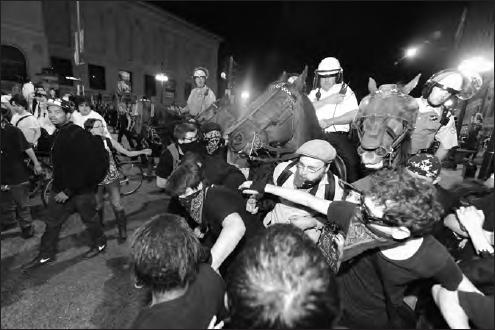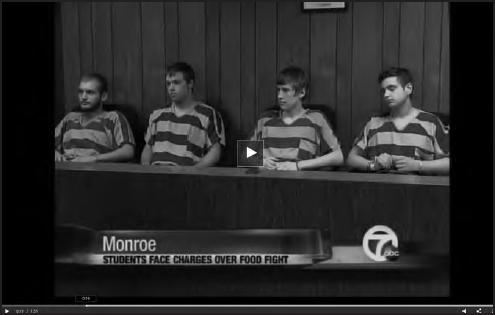A Government of Wolves: The Emerging American Police State (30 page)
Read A Government of Wolves: The Emerging American Police State Online
Authors: John W. Whitehead

It's safe to say that what happened to Steven Howards will, under this law, become a common occurrence. Howards was at a Colorado shopping mall with his son in June 2006 when he learned that then-Vice President Dick Cheney and his Secret Service security detail were at the mall greeting the public. A Secret Service agent overheard Howards telling someone that he was going to approach Cheney, express his opposition to the war in Iraq, and ask him "how many kids he's killed today." Howards eventually approached Cheney and shared his view that Cheney's policies in Iraq "are disgusting." When Cheney turned and began to walk away, Howards brushed the Vice President's shoulder with his hand. The Secret Service subsequently arrested and jailed Howards, charging him with assaulting the Vice President. The assault charges were later dropped.
549
Free Speech Zones
Unfettered free speech is vital to a functioning democracy. Unfortunately the tendency on the part of government and law enforcement officials to purge dissent has largely undermined the First Amendment's safeguards for political free speech. The authoritarian mindset undergirding these roving bubble zones is no different from that which gave rise to "free speech zones," which are government-sanctioned areas located far away from government officials, into which activists and citizens are herded at political rallies and events. Both zones, however, have the same end result: dissent is muted or silenced altogether, and the centers of power are shielded from the citizen.
Free speech zones have become commonplace at political rallies and the national conventions of both major political parties. One of the most infamous free speech zones was erected at the 2004 Democratic National Convention in Boston. Not so much a zone of free expression as a cage, it was a space enclosed by chain link fences, Jersey walls, and razor wire.
550
Judge Douglas Woodlock, who toured the free speech cage before the convention, noted, "One cannot conceive of other elements put in place to make a space more of an affront to the idea of free expression than the designated demonstration zone."
551
Bubble zones and free speech zones, in essence, destroy the very purpose of the First Amendment, which assures us of the right to peaceably assemble and petition the government for a redress of grievances. In other words, we, as citizens, have a constitutional right to address our government officials in a public manner so that they can hear our grievances or concerns. What these zones do, however, is create insulated barriers around public officials, thus keeping us out of sight and sound's reach of those who are supposed to represent us. Many prominent activists, from Occupiers and the Tea Party to antiwar protesters, and so on, are now herded like animals and cordoned off from the view of public officials. Obviously, these zones also serve a secondary purpose, which is to chill free speech by intimidating citizens into remaining silent.

Corralling Protesters (CS Muncy)
Consider this: if these types of laws had been in effect during the Civil Rights movement, there would have been no March on Washington. Martin Luther King Jr. and his fellow activists would have been rendered criminals. And King's call for "militant nonviolent resistance" would have been silenced by police in riot gear.
What's Next?
What's next? There was a time in our nation's history when such an accounting of facts would have sparked immediate outrage. However, having bought into the idea that anything the government says and does is right, even when it is so clearly wrong, many Americans through their own compliance have become unwitting accomplices in the government's efforts to prosecute otherwise law-abiding citizens for unknowingly violating some statute in its vast trove of laws written by bureaucrats who operate above the law. Yet as author Nathan Burney so adeptly points out, "when crimes are too numerous to count... when you're punished, not because what you did was wrong, but simply because the law
says
so... when laws are too vague or overbroad... that's not justice."
552
The Criminalization of America's Schoolchildren
"[P]ublic school reform is now justified in the dehumanizing language of national security, which increasingly legitimates the transformation of schools into adjuncts of the surveillance and police state ... students are increasingly subjected to disciplinary apparatuses which limit their capacity for critical thinking, mold them into consumers, test them into submission, strip them of any sense of social responsibility and convince large numbers of poor minority students that they are better off under the jurisdiction of the criminal justice system than by being valued members of the public schools."
553
-PROFESSOR HENRY GIROUX
F
or those hoping to better understand how and why we arrived at this dismal point in our nation's history, where individual freedoms, privacy, and human dignity have been sacrificed to the gods of security, expediency, and corpocracy look no farther than America's public schools.
Once looked to as the starting place for imparting principles of freedom to future generations, America's classrooms are becoming little more than breeding grounds for compliant citizens. In fact, as director Cevin Soling documents in his insightful, award-winning documentary
The War on Kids,
554
the moment young people walk into school, they increasingly find themselves under constant surveillance: they are photographed, fingerprinted, scanned, x-rayed, sniffed, and snooped on. Between metal detectors at the entrances, drug-sniffing dogs in the hallways, and surveillance cameras in the classrooms and elsewhere, many of America's schools look more like prisons than learning facilities.
Add to this the epidemic of arresting schoolchildren and treating them as if they are dangerous criminals, and you have the makings of a perfect citizenry for the Orwellian society–one that can be easily cowed, controlled, and directed. In fact, what once was looked upon as classically childish behavior such as getting into food fights, playing tag, doodling, hugging, kicking, and throwing temper tantrums is now criminalized.
Arrested Development
Whereas in the past minor behavioral infractions at school such as shooting spitwads may have warranted a trip to the principal's office, in-school detention, or a phone call to one's parents, today they are elevated to the level of criminal behavior with all that implies. Consequently, young people are now being forcibly removed by police officers from the classroom, arrested, handcuffed, transported in the back of police squad cars, and placed in police holding cells until their frantic parents can get them out. For those unlucky enough to be targeted for such punishment, the experience will stay with them long after they are allowed back at school. In fact, it will stay with them for the rest of their lives in the form of a criminal record.
For example, in November 2011, a 14-year-old student in Brevard County, Florida, was suspended for hugging a female friend, an act which even the principal acknowledged as innocent.
555
A 9-year-old in Charlotte, North Carolina, was suspended for sexual harassment after a substitute teacher overheard the child tell another student that the teacher was "cute."
556
A 6-year-old in Georgia was arrested, handcuffed, and suspended for the remainder of the school year after throwing a temper tantrum in class.
557
A 6-year-old boy in San Francisco was accused of sexual assault following a game of tag on the playground.
558
A 6-year-old in Indiana was arrested, handcuffed, and charged with battery after kicking a school principal.
559
Twelve-year-old Alexa Gonzalez was arrested and handcuffed for doodling on a desk.
560
Another student was expelled for speaking on a cell phone with his mother, to whom he hadn't spoken in a month because she was in Iraq on a military deployment.
561
Four high school students in Detroit were arrested and handcuffed for participating in a food fight and charged with a misdemeanor with the potential for a ninety-day jail sentence and a $500 fine.
562
A high school student in Indiana was expelled after sending a profanity-laced tweet through his Twitter account after school hours. The school had been conducting their own surveillance by tracking the tweeting habits of all students.
563

Teens Suspended, Arrested After Food Fight (WXYZ)
The Lockdown in America's Public Schools
These are not isolated incidents. In 2010 some 300,000 Texas schoolchildren received misdemeanor tickets from police officials. One 12-year-old Texas girl had the police called on her after she sprayed perfume on herself during class.
564
In Albuquerque, New Mexico, over 90,000 kids were entered into the criminal justice system during the 2009-2010 school year, and over 500 of those were arrested at school.
565
It is hard to believe that such things–children being handcuffed and carted off to jail for minor incidents–could take place in a so-called "free" country. However, since the introduction of police, high-tech surveillance systems, and zero tolerance policies into the schools, this is the reality with which nearly 50 million students in America's elementary and secondary public schools must contend. Many of these "say no to drugs/say no to violence"-type policies gained favor after the Columbine school shootings in 1999 and have continued to be adopted by school districts across the country. This, even in the wake of research indicating that zero tolerance neither makes schools safer nor discourages violence. "Ironically, the [Columbine] tragedy occurred as rates of school violence in general and shootings in particular were declining," writes author Annette Fuentes in
Lockdown High.
566
Zero Tolerance
Zero tolerance policies, the driving force behind the criminalization of schoolchildren, punish all offenses severely–no matter how minor. Disproportionately levied against minority students and students with emotional and behavioral disabilities,
567
these one-size-fits-all disciplinary procedures mandate suspension or expulsion for students who violate the rules, regardless of the student's intent or the nature of the violation.
Zero tolerance rules in many states also cover fighting, drug or alcohol use, and gang activity, as well as relatively minor offenses such as possessing over-the-counter medications and disrespect of authority. Nearly all American public schools have zero tolerance policies for firearms or other "weapons," and most have such policies for drugs and alcohol. In the wake of the Columbine school shootings, legislators and school boards further tightened their zero tolerance policies, creating what some critics call a national intolerance for childish behavior. As a result, these policies are now interpreted so broadly as to crack down on spit wads, Tweetie Bird key chains, and Certs breath mints–all of which constitute contraband of one kind or another. In some jurisdictions, carrying cough drops, wearing black lipstick, or dying your hair blue are expellable offenses.
